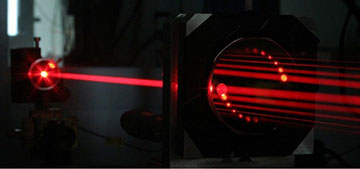
Researchers have developed an extremely sensitive, yet simple optical method for detecting formaldehyde. Their approach is based on multipass spectroscopy. [Image: Mateusz Winkowski, University of Warsaw]
Breath analysis is a promising, noninvasive technique for the diagnosis of disease. Different chemical and physical methods have been investigated to sense disease biomarkers in exhaled breath. However, they each have significant drawbacks, such as the need for expensive or bulky equipment, long measurement times and high detection limits.
Researchers from the University of Warsaw, Poland, are developing a new kind of optical detector for breath analysis based on multipass absorption spectroscopy that boasts high sensitivity and a simple setup (Biomed. Opt. Express, doi: 10.1364/BOE.405384). Initial results demonstrate the device’s ability to detect formaldehyde, a potential biomarker for lung and breast cancer, in low enough concentrations for clinical testing applications.
Cheaper, faster, simpler
Common techniques for breath analysis in a research setting include liquid, gas and ion chromatography, which offer high sensitivity, precision and resolution. The instrumentation for these methods is heavy with a large footprint, making them less than ideal for clinical use in low-resource or remote areas. In addition, chromatography data collection and analysis can take 30 minutes or longer, even for the most “rapid” tests.
Optical approaches have been explored as a simpler, faster alternative to conventional breath-analysis techniques. In the current study, Mateusz Winkowski and Tadeusz Stacewicz employed multipass absorption spectroscopy, which sends a beam of light through a sample multiple times to look for weak absorption spectra.
“Measuring biomarkers in exhaled breath is noninvasive, painless and fast and could be used to screen for cancer even at very early disease stages, which is crucial for successful treatment,” said Winkowski in a press release accompanying the research. “The optical method we developed could make this type of measurement more practical and inexpensive.”
Parts per billion
The research duo’s custom-made multipass cell contains two spherical mirrors on either side that allow the laser beam to bounce back and forth repeatedly, resulting in an optical path length of 17.5 m. Optical interference due to overlapping of the beams, which often spoils the accuracy of an experiment, was reduced by laser wavelength modulation. Winkowski and Stacewicz found that modulation and signal averaging over a certain wavelength range effectively quenches this effect.
This type of optical fringe quenching, along with a proprietary approach to signal analysis, contributed to the very high sensitivity of the optical sensor. When tested on samples of formaldehyde diluted with nitrogen gas, the detection limit was found to be much lower than 6.6 parts per billion, which is more than sufficient to find the cancer biomarker in exhaled breath.
“Our dream is to one day build a tabletop device that would be inexpensive and could be used for cancer screening in any medical consulting room,” said Winkowski. “During a basic medical examination, the patient could blow into the device, and within a minute the doctor would know if the patient might need additional conventional examinations.”
